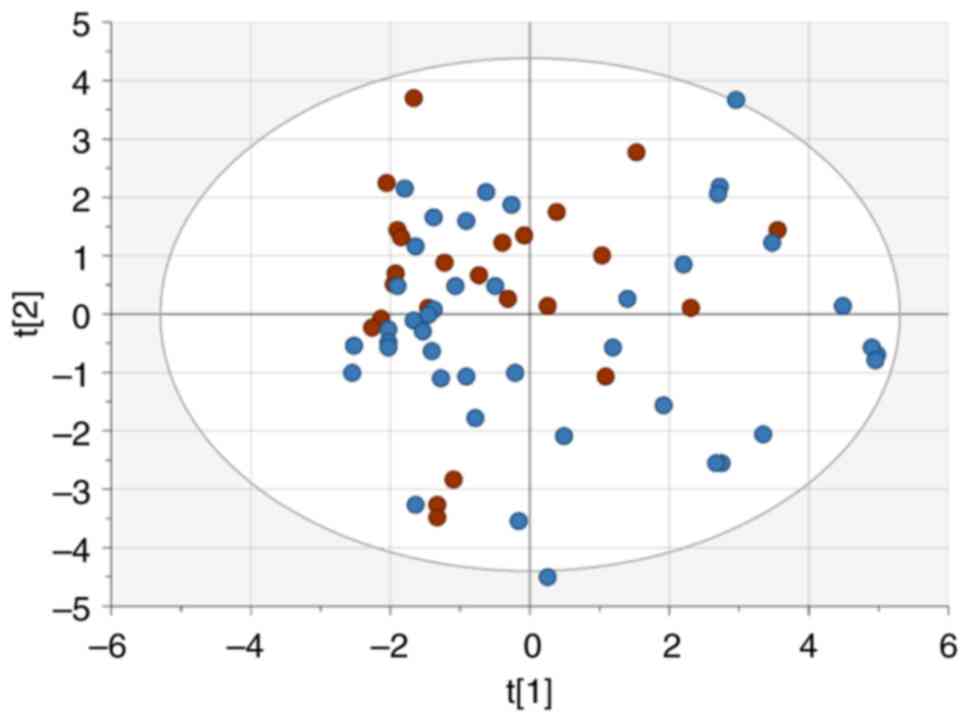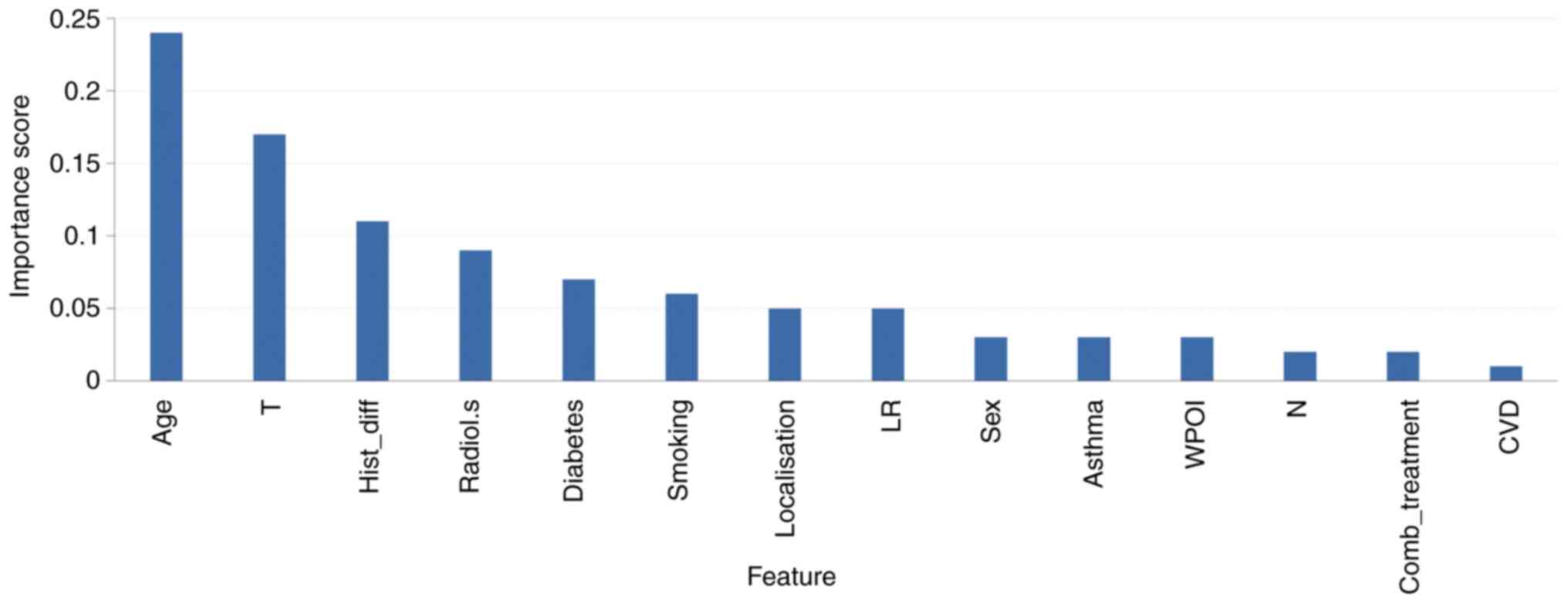|
1
|
Shah JP and Gil Z: Current concepts in
management of oral cancer-surgery. Oral Oncol. 45:394–401. 2009.
View Article : Google Scholar : PubMed/NCBI
|
|
2
|
Marur S and Forastiere AA: Head and neck
cancer: Changing epidemiology, diagnosis, and treatment. Mayo Clin
Proc. 83:489–501. 2008. View
Article : Google Scholar : PubMed/NCBI
|
|
3
|
Lacy PD, Piccirillo JF, Merritt MG and
Zequeira MR: Head and neck squamous cell carcinoma: Better to be
young. Otolaryngol Head Neck Surg. 122:253–258. 2000. View Article : Google Scholar : PubMed/NCBI
|
|
4
|
Bøje CR: Impact of comorbidity on
treatment outcome in head and neck squamous cell carcinoma-a
systematic review. Radiother Oncol. 110:81–90. 2014. View Article : Google Scholar : PubMed/NCBI
|
|
5
|
Bradford CR, Ferlito A, Devaney KO,
Mäkitie AA and Rinaldo A: Prognostic factors in laryngeal squamous
cell carcinoma. Laryngoscope Investig Otolaryngol. 5:74–81. 2020.
View Article : Google Scholar : PubMed/NCBI
|
|
6
|
Huang Y, Xiao X, Sadeghi F, Feychting M,
Hammar N, Fang F, Zhang Z and Liu Q: Blood metabolic biomarkers and
the risk of head and neck cancer: An epidemiological study in the
Swedish AMORIS Cohort. Cancer Lett. 557:2160912023. View Article : Google Scholar : PubMed/NCBI
|
|
7
|
Gu X, Wang L, Coates PJ, Boldrup L,
Fahraeus R, Wilms T, Norberg-Spaak L, Sgaramella N and Nylander K:
Transfer-RNA-derived fragments are potential prognostic factors in
patients with squamous cell carcinoma of the head and neck. Genes
(Basel). 11:13442020. View Article : Google Scholar : PubMed/NCBI
|
|
8
|
Gu X, Wang L, Boldrup L, Coates P,
Fahraeus R, Sgaramella N, Wilms T and Nylander K: AP001056.1, A
prognosis-related enhancer RNA in squamous cell carcinoma of the
head and neck. Cancers (Basel). 11:3472019. View Article : Google Scholar : PubMed/NCBI
|
|
9
|
Warner GC, Reis PP, Jurisica I, Sultan M,
Arora S, Macmillan C, Makitie AA, Grénman R, Reid N, Sukhai M, et
al: Molecular classification of oral cancer by cDNA microarrays
identifies overexpressed genes correlated with nodal metastasis.
Int J Cancer. 110:857–868. 2004. View Article : Google Scholar : PubMed/NCBI
|
|
10
|
Zhang F, Liu Y, Yang Y and Yang K:
Development and validation of a fourteen-innate immunity-related
gene pairs signature for predicting prognosis head and neck
squamous cell carcinoma. BMC Cancer. 20:10152020. View Article : Google Scholar : PubMed/NCBI
|
|
11
|
Zhou RS, Zhang EX, Sun QF, Ye ZJ, Liu JW,
Zhou DH and Tang Y: Integrated analysis of lncRNA-miRNA-mRNA ceRNA
network in squamous cell carcinoma of tongue. BMC Cancer.
19:7792019. View Article : Google Scholar : PubMed/NCBI
|
|
12
|
Sgaramella N, Gu X, Boldrup L, Coates PJ,
Fåhraeus R, Califano L, Tartaro G, Colella G, Spaak LN, Strom A, et
al: Searching for new targets and treatments in the battle against
squamous cell carcinoma of the head and neck, with specific focus
on tumours of the tongue. Curr Top Med Chem. 18:214–218. 2018.
View Article : Google Scholar : PubMed/NCBI
|
|
13
|
Brandwein-Gensler M, Teixeira MS, Lewis
CM, Lee B, Rolnitzky L, Hille JJ, Genden E, Urken ML and Wang BY:
Oral squamous cell carcinoma histologic risk assessment, but not
margin status, is strongly predictive of local disease-free and
overall survival. Am J Surg Pathol. 29:167–178. 2005. View Article : Google Scholar : PubMed/NCBI
|
|
14
|
Svetnik V, Liaw A, Tong C, Culberson JC,
Sheridan RP and Feuston BP: Random forest: A classification and
regression tool for compound classification and QSAR modeling. J
Chem Inf Comput Sci. 43:1947–1958. 2003. View Article : Google Scholar : PubMed/NCBI
|
|
15
|
Pedregosa F, Varoquaux G, Gramfort A,
Michel V, Thirion B, Grisel O, Blondel M, Prettenhofer P, Weiss R,
Dubourg V, et al: Scikit-learn: Machine learning in python. J Mach
Learn Res. 12:2825–2830. 2011.
|
|
16
|
Alabi RO, Elmusrati M, Sawazaki-Calone I,
Kowalski LP, Haglund C, Coletta RD, Mäkitie AA, Salo T, Almangush A
and Leivo L: Comparison of supervised machine learning
classification techniques in prediction of locoregional recurrences
in early oral tongue cancer. Int J Med Inform. 136:1040682020.
View Article : Google Scholar : PubMed/NCBI
|
|
17
|
Alabi RO, Elmusrati M, Leivo I, Almangush
A and Mäkitie AA: Machine learning explainability in nasopharyngeal
cancer survival using LIME and SHAP. Sci Rep. 13:89842023.
View Article : Google Scholar : PubMed/NCBI
|
|
18
|
Alabi RO, Almangush A, Elmusrati M, Leivo
I and Mäkitie A: Measuring the usability and quality of
explanations of a machine learning web-based tool for oral tongue
cancer prognostication. Int J Environ Res Public Health.
19:83662022. View Article : Google Scholar : PubMed/NCBI
|
|
19
|
Alabi RO, Almangush A, Elmusrati M and
Mäkitie AA: Deep machine learning for oral cancer: From precise
diagnosis to precision medicine. Front Oral Health. 2:7942482022.
View Article : Google Scholar : PubMed/NCBI
|
|
20
|
Giovannucci E, Harlan DM, Archer MC,
Bergenstal RM, Gapstur SM, Habel LA, Pollak M, Regensteiner JG and
Yee D: Diabetes and cancer, a consensus report. Diabetes Care.
33:1674–1685. 2010. View Article : Google Scholar : PubMed/NCBI
|
|
21
|
Wojciechowska J, Krajewski W, Bolanowski
M, Kręcicki T and Zatoński T: Diabetes and cancer: A review of
current knowledge. Exp Clin Endocrinol Diabetes. 124:263–275. 2016.
View Article : Google Scholar : PubMed/NCBI
|
|
22
|
Hadad SM, Coates P, Jordan LB, Dowling RJ,
Chang MC, Done SJ, Purdie CA, Goodwin PJ, Stambolic V,
Moulder-Thompson S, et al: Evidence for biological effects of
metformin in operable breast cancer: Biomarker analysis in a
pre-operative window of opportunity randomized trial. Breast Cancer
Res Treat. 150:149–155. 2015. View Article : Google Scholar : PubMed/NCBI
|
|
23
|
Noto H, Goto A, Tsujimoto T and Noda M:
Cancer risk in diabetic patients treated with metformin: A
systematic review and meta-analysis. PLoS One. 7:e334112012.
View Article : Google Scholar : PubMed/NCBI
|
|
24
|
Dickerman BA, García-Albéniz X, Logan RW,
Denaxas S and Hernán MA: Evaluating metformin strategies for cancer
prevention: A target trial emulation using electronic health
records. Epidemiology. 34:690–699. 2023. View Article : Google Scholar : PubMed/NCBI
|
|
25
|
Hu X, Xiong H, Chen W, Huang L, Mao T,
Yang L, Wang C, Huang D, Wang Z, Yu J, et al: Metformin reduces the
increased risk of oral squamous cell carcinoma recurrence in
patients with type 2 diabetes mellitus: A cohort study with
propensity score analyses. Surg Oncol. 35:453–459. 2020. View Article : Google Scholar : PubMed/NCBI
|
|
26
|
Gutkind JS, Molinolo AA, Wu X, Wang Z,
Nachmanson D, Harismendy O, Alexandrov LB, Wuertz BR, Ondrey FG,
Laronde D, et al: Inhibition of mTOR signaling and clinical
activity of metformin in oral premalignant lesions. JCI Insight.
6:e1470962021. View Article : Google Scholar : PubMed/NCBI
|
|
27
|
Lee DJ, McMullen CP, Foreman A, Huang SH,
Lu L, Xu W, de Almeida JR, Liu G, Bratman SV and Goldstein DP:
Impact of metformin on disease control and survival in patients
with head and neck cancer: A retrospective cohort study. J
Otolaryngol Head Neck Surg. 48:342019. View Article : Google Scholar : PubMed/NCBI
|
|
28
|
Barrea L, Caprio M, Tuccinardi D, Moriconi
E, Di Renzo L, Muscogiuri G, Colao A and Savastano S: Could
ketogenic diet ‘starve’ cancer? Emerging evidence. Crit Rev Food
Sci Nutr. 62:1800–1821. 2022. View Article : Google Scholar : PubMed/NCBI
|
|
29
|
Marcucci F and Rumio C: Glycolysis-induced
drug resistance in tumors-A response to danger signals? Neoplasia.
23:234–245. 2021. View Article : Google Scholar : PubMed/NCBI
|
|
30
|
Spanier G, Ugele I, Nieberle F, Symeou L,
Schmidhofer S, Brand A, Meier J, Spoerl S, Krupar R, Rümmele P, et
al: The predictive power of CD3+ T cell infiltration of
oral squamous cell tumors is limited to non-diabetic patients.
Cancer Lett. 499:209–219. 2021. View Article : Google Scholar : PubMed/NCBI
|
|
31
|
Lundqvist L, Stenlund SH, Laurell G and
Nylander K: The importance of stromal inflammation in squamous cell
carcinoma of the tongue. J Oral Pathol Med. 41:379–383. 2012.
View Article : Google Scholar : PubMed/NCBI
|












